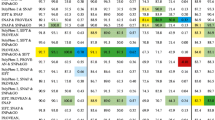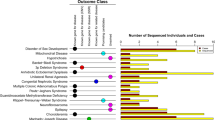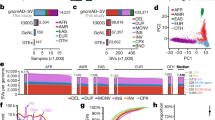Abstract
Despite the overrepresentation of Kv7.1 mutations among patients with a robust diagnosis of long QT syndrome (LQTS), a background rate of innocuous Kv7.1 missense variants observed in healthy controls creates ambiguity in the interpretation of LQTS genetic test results. A recent study showed that the probability of pathogenicity for rare missense mutations depends in part on the topological location of the variant in Kv7.1’s various structure-function domains. Since the Kv7.1’s C-terminus accounts for nearly 50 % of the overall protein and nearly 50 % of the overall background rate of rare variants falls within the C-terminus, further enhancement in mutation calling may provide guidance in distinguishing pathogenic long QT syndrome type 1 (LQT1)-causing mutations from rare non-disease-causing variants in the Kv7.1’s C-terminus. Therefore, we have used conservation analysis and a large case-control study to generate topology-based estimative predictive values to aid in interpretation, identifying three regions of high conservation within the Kv7.1’s C-terminus which have a high probability of LQT1 pathogenicity.





Similar content being viewed by others
References
Wang, Q., Curran, M. E., Splawski, I., Burn, T. C., Millholland, J. M., VanRaay, T. J., Shen, J., Timothy, K. W., Vincent, G. M., de Jager, T., Schwartz, P. J., Toubin, J. A., Moss, A. J., Atkinson, D. L., Landes, G. M., Connors, T. D., & Keating, M. T. (1996). Positional cloning of a novel potassium channel gene: KVLQT1 mutations cause cardiac arrhythmias. Nature Genetics, 12(1), 17–23.
Perrin, M. J., & Gollob, M. H. (2013). Genetics of cardiac electrical disease. The Canadian Journal of Cardiology, 29(1), 89–99. doi:10.1016/j.cjca.2012.07.847.
Ackerman, M. J. (2004). Cardiac channelopathies: it’s in the genes. Nature Medicine, 10(5), 463–464. doi:10.1038/nm0504-463.
Kapa, S., Tester, D. J., Salisbury, B. A., Harris-Kerr, C., Pungliya, M. S., Alders, M., Wilde, A. A., & Ackerman, M. J. (2009). Genetic testing for long-QT syndrome: distinguishing pathogenic mutations from benign variants. Circulation, 120(18), 1752–1760.
Green, R. C., Berg, J. S., Grody, W. W., Kalia, S. S., Korf, B. R., Martin, C. L., McGuire, A. L., Nussbaum, R. L., O’Daniel, J. M., Ormond, K. E., Rehm, H. L., Watson, M. S., Williams, M. S., & Biesecker, L. G. (2013). ACMG recommendations for reporting of incidental findings in clinical exome and genome sequencing. Genetics in Medicine: Official Journal of the American College of Medical Genetics, 15(7), 565–574. doi:10.1038/gim.2013.73.
Giudicessi, J. R., Kapplinger, J. D., Tester, D. J., Alders, M., Salisbury, B. A., Wilde, A. A. M., & Ackerman, M. J. (2012). Phylogenetic and physicochemical analyses enhance the classification of rare nonsynonymous single nucleotide variants in type 1 and 2 long-QT syndrome. Circulation-Cardiovascular Genetics, 5(5), 519–528.
Abecasis, G. R., Auton, A., Brooks, L. D., DePristo, M. A., Durbin, R. M., Handsaker, R. E., Kang, H. M., Marth, G. T., & McVean, G. A. (2012). An integrated map of genetic variation from 1,092 human genomes. Nature, 491(7422), 56–65. doi:10.1038/nature11632.
Wiener, R., Haitin, Y., Shamgar, L., Fernandez-Alonso, M. C., Martos, A., Chomsky-Hecht, O., Rivas, G., Attali, B., & Hirsch, J. A. (2008). The KCNQ1 (Kv7.1) COOH terminus, a multitiered scaffold for subunit assembly and protein interaction. Journal of Biological Chemistry, 283(9), 5815–5830. doi:10.1074/jbc.M707541200.
Tester, D. J., Will, M. L., Haglund, C. M., & Ackerman, M. J. (2005). Compendium of cardiac channel mutations in 541 consecutive unrelated patients referred for long QT syndrome genetic testing. Heart Rhythm, 2(5), 507–517.
Kapplinger, J. D., Tester, D. J., Salisbury, B. A., Carr, J. L., Harris-Kerr, C., Pollevick, G. D., Wilde, A. A., & Ackerman, M. J. (2009). Spectrum and prevalence of mutations from the first 2,500 consecutive unrelated patients referred for the FAMILION long QT syndrome genetic test. Heart Rhythm, 6(9), 1297–1303.
Refsgaard, L., Holst, A. G., Sadjadieh, G., Haunso, S., Nielsen, J. B., & Olesen, M. S. (2012). High prevalence of genetic variants previously associated with LQT syndrome in new exome data. European Journal of Human Genetics: EJHG, 20(8), 905–908. doi:10.1038/ejhg.2012.23.
Giudicessi, J. R., & Ackerman, M. J. (2013). Genotype- and phenotype-guided management of congenital long QT syndrome. Current Problems in Cardiology, 38(10), 417–455. doi:10.1016/j.cpcardiol.2013.08.001.
Ware, J. S., Walsh, R., Cunningham, F., Birney, E., & Cook, S. A. (2012). Paralogous annotation of disease-causing variants in long QT syndrome genes. Human Mutation, 33(8), 1188–1191. doi:10.1002/humu.22114.
Zheng, R., Thompson, K., Obeng-Gyimah, E., Alessi, D., Chen, J., Cheng, H., & McDonald, T. V. (2010). Analysis of the interactions between the C-terminal cytoplasmic domains of KCNQ1 and KCNE1 channel subunits. Biochemical Journal, 428(1), 75–84. doi:10.1042/BJ20090977.
Schmitt, N., Calloe, K., Nielsen, N. H., Buschmann, M., Speckmann, E. J., Schulze-Bahr, E., & Schwarz, M. (2007). The novel C-terminal KCNQ1 mutation M520R alters protein trafficking. Biochemical and Biophysical Research Communications, 358(1), 304–310. doi:10.1016/j.bbrc.2007.04.127.
Sato, A., Arimura, T., Makita, N., Ishikawa, T., Aizawa, Y., Ushinohama, H., & Kimura, A. (2009). Novel mechanisms of trafficking defect caused by KCNQ1 mutations found in long QT syndrome. Journal of Biological Chemistry, 284(50), 35122–35133. doi:10.1074/jbc.M109.017293.
Wedekind, H., Schwarz, M., Hauenschild, S., Djonlagic, H., Haverkamp, W., Breithardt, G., Wulfing, T., Pongs, O., Isbrandt, D., & Schulze-Bahr, E. (2004). Effective long-term control of cardiac events with beta-blockers in a family with a common LQT1 mutation. Clinical Genetics, 65(3), 233–241.
Kapplinger, J. D., Landstrom, A. P., Bos, J. M., Salisbury, B. A., Callis, T. E., & Ackerman, M. J. (2014). Distinguishing hypertrophic cardiomyopathy-associated mutations from background genetic noise. Journal of Cardiovascular Translational Research, 7(3), 347–361. doi:10.1007/s12265-014-9542-z.
Ruklisa, D., Ware, J. S., Walsh, R., Balding, D. J., & Cook, S. A. (2015). Bayesian models for syndrome- and gene-specific probabilities of novel variant pathogenicity. Genome Medicine, 7(1), 5. doi:10.1186/s13073-014-0120-4.
Acknowledgments
J.D.K. is supported by the NIH grant GM72474-08 and thanks the Mayo Clinic MSTP for fostering an outstanding environment for physician-scientist training. This project was supported by the Mayo Clinic Windland Smith Rice Comprehensive Sudden Cardiac Death Program (M.J.A.). We acknowledge the support from the Netherlands CardioVascular Research Initiative (CVON-PREDICT project): the Dutch Heart Foundation, Dutch Federation of University Medical Centres, the Netherlands Organisation for Health Research and Development, and the Royal Netherlands Academy of Sciences (A.A.M.W.).
Disclosures
T.E.C. is an employee of Transgenomic Inc. B.A.S. is an employee of Knome, Inc. M.J.A. is a consultant for Boston Scientific, Gilead Sciences, Medtronic, St. Jude Medical, Inc., and Transgenomic. Intellectual property derived from M.J.A.’s research program resulted in license agreements in 2004 between Mayo Clinic Ventures (formerly Mayo Medical Ventures) and Genaissance Pharmaceuticals (now Transgenomic) with respect to their FAMILION-LQTS and FAMILION-CPVT genetic tests.
Author information
Authors and Affiliations
Corresponding author
Additional information
Associate Editor Paul J. R. Barton oversaw the review of this article.
Jamie D. Kapplinger and Andrew S. Tseng contributed equally to this work.
Electronic Supplementary Material
Below is the link to the electronic supplementary material.
ESM 1
(DOCX 34 kb)
Rights and permissions
About this article
Cite this article
Kapplinger, J.D., Tseng, A.S., Salisbury, B.A. et al. Enhancing the Predictive Power of Mutations in the C-Terminus of the KCNQ1-Encoded Kv7.1 Voltage-Gated Potassium Channel. J. of Cardiovasc. Trans. Res. 8, 187–197 (2015). https://doi.org/10.1007/s12265-015-9622-8
Received:
Accepted:
Published:
Issue Date:
DOI: https://doi.org/10.1007/s12265-015-9622-8




